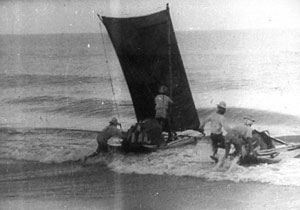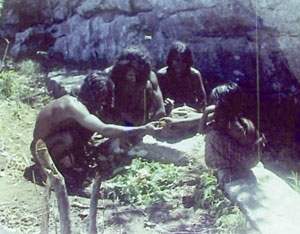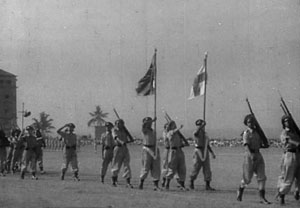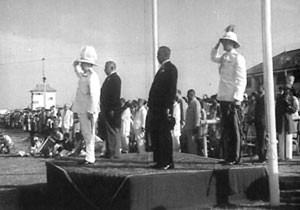In 1984 I was requested to compile archive footage on Sri Lanka for a tourist promotion project, Transervice, and was granted permission to copy any of the scores of Government Film Unit (GFU) documentaries and newsreels produced over the previous 36 yeas. Some of these predominantly black-and-white films, especially those from the late 1940s and 1950s, impressed on me the enormous artistic, cultural and social heritage the GFU had captured on celluloid. At the same time, however, it became clear that the preservation of the negatives was almost non-existent.
Walking through the intolerably hot film library – nothing more than a shed - I could almost hear the dangerous chemical reactions occurring inside rusting film cans where negatives stewed in their own juices.
From around that time many film historians and filmmakers - especially Lester James Peries, who began his career at the GFU - pleaded for an urgent project to restore and preserve the country’s documentary record. Frustratingly, the urgency wasn’t understood by the succession of bureaucrats who had to make the ultimate decisions since a government institution was involved. A quarter of a century had elapsed without action when Sharadha de Saram, a former documentary filmmaker for the current affairs division at the Sri Lanka Rupavahini Corporation, casually mentioned the idea of a project to digitize the films to an assistant cultural affairs officer of the US Embassy.
The suggestion was met with enthusiasm and the project was implemented in 2008, a partnership between the US Ambassador’s Fund for Cultural Preservation - which gifted a modest US $ 18,580 - and the GFU. De Saram, appointed project director, was fortunate to enjoy the consultancy services of Tissa Abeysekara, an accomplished GFU documentary-maker, feature director, scriptwriter, novelist, and film historian. His experience with the GFU and knowledge of the material was invaluable in the major task of selection, which resulted in 170 documentaries and newsreels being screened for assessment. Only 35mm material was considered, the 16mm material being sidelined for a future project. To match the budgetary allocation, 100 films were selected for digitization, and prior restoration was limited to cleaning the copies of the films. Clearly greater funding was necessary to compile a more comprehensive selection and cover meaningful computer-assisted restoration.
 |
 |
 |
 |
| Top To Bottom : Stills from Meegamuwe mas maranno, The Living Wild and the first Independence Day celebrations |
Alas, Abeysekara died during the last stages of this work, his major contribution to the country’s cinematic history. Thus his absence at the special screening on May 12 of three documentaries and a newsreel to mark the completion of the project dampened the occasion. A major festival to screen most or all the films to attract film historians and documentary-makers worldwide would be the ideal method to showcase this documentary heritage.
As it is the films are being broadcast on television, but without contextualization and evaluation these mostly black-and-white films - some of indifferent visual quality, all displaying outdated production techniques - are likely to compel viewers to switch channels.
A parallel project, a catalogue of 70 of the films and newsreels, “Preserving the Documentary Film Heritage of Sri Lanka: Films in the care of the Government Film Unit since Independence”, was published to coincide with the project’s completion, again with American funding, this time from the Asia Foundation. Because of the paucity of published material on the subject of Sri Lanka’s documentary tradition any additional publication is welcome, in particular this catalogue, which contains comprehensive credits, detailed production notes, and evocative stills from the films.
But for the film historian the introduction is frustratingly short of details regarding the execution of the project. A special copy of the catalogue given to the GFU forms the master reference guide and contains notes on the condition of every film, indicating whether the negative or positive is available and recommending further conservation measures. As a result, funds have been requested to restore negatives and provide plastic film cans to replace the metal ones. In addition, proper storage space has been created with de-humidifyers and air-conditioning.
Excerpts from my writings on Sri Lanka’s documentaries were used to create an introductory short history of the GFU for the catalogue. At the inception of the GFU in 1948 the country was seeking a post-Independence identity, but the lack of Ceylonese technical personnel necessitated the recruitment of outsiders – in the first instance two Italians, Giulio Petroni (director) and Federico Serra (sound). Furthermore, one of their initial productions, The First Year Anniversary Celebrations of Independence (1949), reveals the lingering British presence in the then Dominion of Ceylon. This is symbolized by the chief guest, the country’s Governor-General, Sir Henry Monck-Mason Moore, the playing of the British national anthem, fly-pasts by World War Two-vintage Lancaster bombers and Sunderland flying-boats, and parades by Royal Air Force and Royal Marines personnel.
Newsreels were produced every month. Fortunately, Ceylon News No. 1 (1949) has been located. It’s an eclectic gem. One item features the departure of sacred Buddha relics to Burma, whose Prime Minister was General Aung San, father of Aung San Suu Kyi. Another records a bizarre rendition of the country’s Independence March by the visiting French crooner Sacha “Raindrops Keep Falling on My Head” Distel (on this occasion playing a trombone) accompanied by his band. Then there’s a tennis match held in Colombo between the American professionals Gussie Moran and Pat Todd. In 1949, the year it was filmed, Moran had been accused by the Wimbledon authorities of bringing “vulgarity and sin into tennis” by wearing a short dress with lace-trimmed knickers that earned her the sobriquet ‘Gorgeous Gussie’.
Most newsreels were more mundane. Ceylon News No. 13 (1950), for instance, includes the opening of a cement factory in Kankesanthurai, the inauguration of the office of the Minister of State, and the annual National Physique Contest.
Ceylon News No. 14 (1950), however, is of great relevance to film historians as the main item concerns the making of Carol Reed’s Outcast of the Islands (1952), based on Joseph Conrad’s novel and starring Ralph Richardson and Trevor Howard. It includes an interview with Reed in which he comments on the reasons for choosing Ceylon as a location.
The first GFU documentary of significance was Hill Capital (1950), directed by Petroni. Focusing on the cultural aspect of the hill capital, Kandy, it captures Kandyan dancing when it was of a greater aesthetic standard, and the Kandy Esala Perahera when it was far more traditional.
Petroni left the GFU in 1950. What the catalogue doesn’t mention – understandably - is the background to his departure. In 1949, Lilamini Seneviratne, wife of biscuit heir Nicky Seneviratne, scandalized Colombo society by leaving her husband for Petroni. In 1951 they married and moved to Italy. Lilamini had studied Bharata Natyam and was considered a great exponent of the form. Now she captivated Italy with her performances. But her marriage to Petroni foundered and in 1958 she married Shiv Kapoor, a wealthy shipowner. Of interest is that Petroni later began to direct spaghetti westerns such as Death Rides a Horse (1967), starring Lee van Cleef, Tepepa (1968), which included an appearance by Orson Welles, and Night of the Serpent (1969). In 1993 he returned to Sri Lanka to make a documentary on the country for Radiotelevisione Italiana (RAI) and was appalled to find the GFU using some of the equipment he used 45 years earlier. “These are antiques that belong in a museum,” he informed a journalist.
Six months after Petroni’s departure, a leading documentary production company in London - the Film Producers’ Guild - sent one of its directors to Ceylon with the aim of getting the government interested in making films jointly. The person concerned was India-born Ralph Keene, a leading light of the second wave of British documentary-makers who directed New Britain (1940), scripted by Graham Greene, and Cyprus is an Island (1946), scripted by Laurie Lee. Soon Keene was under contract to make two documentaries a year. Thankfully his staunch belief was that, along with propaganda films and newsreels, prestige documentaries of cultural value should also be made.
Keene had travelled to Ceylon before to make String of Beads (1947) for the Ceylon Tea Propaganda Board. His first GFU film, which he wrote rather than directed, was Fishermen of Negombo (1952). The director was George Wickremasinghe, the pioneer of indigenous documentary-making. The footage is of significance as the fishermen’s way of life portrayed has long disappeared. One of the outstanding aspects of this film is the score, rich with the rhythm and the melodies of Sinhala folk music, by the country’s iconic traditional musician, Deva Surya Sena.
Keene then directed Heritage of Lanka (1952), which is divided into four parts, each documenting an ancient city or pilgrim site - Mihintale, Anuradhapura, Polonnaruwa and Sri Pada – and Nelungama (1953), the story of a village and its people. His contract over, Keene left to join the Malaysia Film Unit and returned to London several years later and directed many documentaries including Journey into Spring (1958), nominated for two Oscars.
George Wickremasinghe became head of the GFU: now was the time for Ceylonese directors to cut their teeth. Amid the scores of films made during the halcyon years of the 1950s, one that stands out is Lester James Peries’ Conquest of the Dry Zone (1954), which centres on the measures adopted to combat malaria, apparently one of the greatest success stories of public health in South Asia. This documentary received a special mention at the Venice Film Festival.
One important documentary from this period that must be mentioned even though it is not included in the catalogue is Pragnasoma Hettiarachchi’s Makers, Motifs and Materials (1958), a highly creative film in colour concerning the making of traditional handicrafts (watch it on YouTube), which was awarded the Golden Mercury Prize at the Venice Film Festival. Hettiarachchi directed another significant documentary in colour, Rhythms of the People (1958/1959/1960), a sensitive record of southern folk songs and dances (also on YouTube) that received an honourable mention at the Karlovy Vary International Festival.
Irwin Dassanayake’s The Living Wild (1959), also in colour, is considered of great anthropological value as it is the only comprehensive record of the traditions of the indigenous community, the Veddahs, before their inevitable social transformation occurred. This documentary deservedly received an honourable mention at the Vancouver International Film Festival.
By the mid-1960s the GFU had reached a state of creative stagnation, partly due to the uninspiring films commissioned. Basil Wright, director of the classic Song of Ceylon (1934) – also on YouTube - expressed willingness to help out: “The length of my stay in Ceylon would depend on the size and scope of the film or films to be made . . . As regards technical assistance, I have the impression that you have a well-equipped and experienced Unit, members of which I would be glad to work with.” But Wright never made his return to the island. Bureaucratic indifference resulted in a consummate opportunity being squandered.
Instead the renowned German director Paul Zils was attached to the GFU as a consultant during 1968-69 courtesy of the West German government. Zils had been a favourite of Hitler’s Propaganda Minister Joseph Goebbels, but fled Nazism and arrived in Hollywood in 1939 to work as assistant director to Max Reinhardt. He then travelled to the Far East but was arrested in Bali by the British in the Second World War and made a POW. But his filmmaking was appreciated and on release he was appointed head of Information Films of India, and directed many excellent documentaries such as Hindustan Hamara (1950), Fisherfolk of Bombay (1955), and The Vanishing Tribe (1959). He singlehandedly gave shape to the independent documentary film movement in India.
Zils was absorbed by Buddhism and had travelled to Ceylon earlier to make Buddhism in Ceylon (1963). Little surprise, then, that his first film for the GFU was Meditation (1968), a beautiful, reflective docu-fiction about a middle-aged doctor who, after reviewing his life, decides to become a Buddhist monk. Having completed his consultancy, Zils continued to live in Ceylon for several years and the GFU invited him to direct other films: Time and the Nation (1970) tackles the intractable problem of postponement, while For a Better Tomorrow (1975) focuses on rural development such as coastal fishing and agricultural methods.
My thumbnail documentation of the documentary in Sri Lanka ceases at this point, although the catalogue lists films produced as recently as 2008! During the 1970s the GFU lost much of its former glory. Besides, the ‘pure’ form of documentary epitomized by Song of Ceylon was over. A new age of non-fiction film had dawned. And a decade later the advent of television in Sri Lanka was inevitably deleterious.
However, I’d like to finish by paying homage to Tissa Abeysekara by mentioning his classic Kamam (late 1970s), screened on May 12. It’s a documentary on the agricultural life of the people of Jaffna described through Tamil folk songs - so refreshing to hear once more. Capturing beautiful landscapes that have become unfamiliar to us ‘southerners’ cut off from the north for so long, and featuring the traditional life of the people of Jaffna, this is a film that requires to be screened to assist in the reintegration of the peoples of Sri Lanka. |





